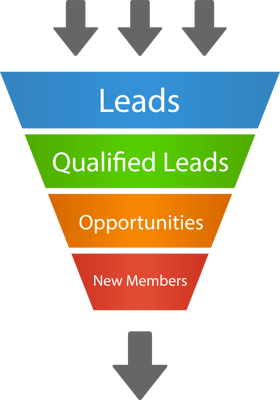Adding "Traction" and Structure for Private Club Management [Ep. 25]
Running a multi-million dollar enterprise is serious business and private club managers know it’s not easy to coordinate a team of people on a daily...
5 min read
 Kathy Heil
:
Feb 15, 2023 10:30:00 AM
Kathy Heil
:
Feb 15, 2023 10:30:00 AM

Like most businesses, private clubs tend to underspend on marketing. Your club has a logo, website, and marketing materials, which is the foundation of your club's branding. But successful club marketing doesn't end there. According to Club Benchmarking, the median membership and marketing expense was only 1% of revenue and included all payroll, taxes, and benefits! It goes without saying that the right marketing budget for clubs is probably several percentage points north of current spending levels.
The average attrition rate for clubs across the country is about 10%. This means that 10% of the membership will turn over year-to-year. That said, it's important to have a plan to consistently bring new members in the door, preferably one that goes beyond "word-of-member" marketing.
If you are a club that doesn’t have a sales and marketing budget, go ask for one! Your marketing budget serves as a map to ensure you reach your club’s membership goals. As a quick rule of thumb check your club's spending by this statistic; Non-profit organizations spend approximately 5-15% of their projected gross revenues in marketing and communications. The planning required to develop a private club marketing budget will not only help define and align your club's goals, but it will also provide a strong case for allocating dollars to marketing.
Consider the cost of doing nothing or simply maintaining the status quo. Are you trying to add more members next year? Have you planned and funded the initiatives that will help you reach that goal? If you want different results, you’ll need to do something different.
If you've never prepared a budget before, or you're looking to make a case for a larger budget, here is a four-step approach to developing a marketing budget as part of a marketing plan:
Building a marketing budget requires a deep understanding of your membership funnel. If you have a CRM or marketing automation software, you can harvest the following data. If you don’t have a technology tool, you'll have to gather the data manually, which makes generating any type of ROI reporting impossible.
What’s the average value of that membership?

Not every person who fills out a “contact us” form or who is referred by a member becomes a member. So, knowing the answers to these important questions tells you how many leads you need to attract to reach your desired number of new members each yearFrom what you can see in the illustration, not every person who fills out a “contact us” form or who is referred by a member becomes a member. So, knowing the answers to these important questions tells you how many leads you need to attract to reach your desired number of new members each year.
Now, it’s time to build the foundation of your marketing plan with clear numbers. Start by asking these questions:
Once you understand your membership funnel, you know how many leads are required to generate the desired number of new members, so you can begin setting your SMART goals.
Smart goals are Specific, Measurable, Attainable, Relevant, and Timely. Some examples of SMART goals include:
To understand costs, you need to create a plan. Budgeting and planning are iterative processes. You will add details and make adjustments based on the research you do and the feedback you get.
Begin by listing your top initiatives to find prospective members, nurture existing prospects, and close new members. Include the tactics and metrics you’ll use to define success.
For example, how many club tours do you need? How many member referrals do you typically rely on? How many website visitors does it take to fill your pipeline? How many leads can you predictably generate with Facebook ads?
At this point, you don’t need the nitty-gritty of your marketing plan, but you should have some ideas of what you’re planning to do to achieve your goals.
The following categories represent the main “buckets” to consider. What you include in the line item budget will change from year to year based on your goals, initiatives, and past results.
If you’re not sure where to start to plan your club’s marketing budget, perhaps our free Private Club Marketing Budget Template can help you build out your plan. Included is a budget summary and monthly tracker for paid promos, branding and creative, website, content, PR, events and personnel costs!
Developing a plan and budget to support your club's goals is just the beginning. In order for it to succeed, you need experts in marketing and design–some of whom may already be part of your team while others may have to be hired externally. It is important to have the right technology in place so that you can measure outcomes and know what tactics need to be adjusted. It all comes down to monitoring progress regularly and being ready to modify your strategy as necessary if results don't meet expectations.
Investing in the right tools, technology, and resources when it comes to private club marketing can be invaluable. Read how Greystone Golf & Country Club leaned into marketing strategies to transform their club membership. A strategic marketing spend and willingness to embrace forward-thinking ideas are essential to succeed in today’s market. A detailed marketing budget, along with a thoughtful marketing plan, create the necessary foundation for club success.

Running a multi-million dollar enterprise is serious business and private club managers know it’s not easy to coordinate a team of people on a daily...
![Creating a Video Strategy to Grow Club Revenue and Reduce Expenses [Episode 12]](https://www.storytellermn.com/hubfs/CCMBlogHeaderEp12.jpg)
Look around online and it’s hard not to find video. From social media feeds to websites, video is everywhere. Yet it’s not enough to produce one...
![Managing Private Golf Club Waitlists: What You Need To Know [Ep. 31]](https://www.storytellermn.com/hubfs/2021-clean/images/blog/CCM%20-%20Managing%20Private%20Club%20Waitlists%20%281%29.jpg)
For the first time in years, many private golf clubs have a waitlist for new members. For the clubs who have always had waitlists, this is nothing...